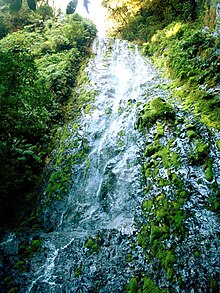
La Tigra National Park (Parque Nacional La Tigra in Spanish) is one of Honduras' most popular parks with easy access to the capital city of Tegucigalpa. The park is a mountainous rainforest with excellent hiking trails and a remarkable diversity of wildlife including over 350 species of avians, making it ideal for birdwatching.
Understand
[edit]This is a large park, covering an area of 23,800 hectares.
History
[edit]La Tigra became the first park in the Honduras national parks system in 1980, although it had been protected as a nature reserve for almost 30 years prior to that. In the first half of the 20th century, the area suffered from deforestation as trees were regularly cut as building supplies for the growing capital city nearby as well as to supply firewood to nearby communities. Since the government stepped in, the park's recovery has been remarkable with new growth oak forest thriving in the wet mountainous landscape. As the forests matured, wildlife returned.
Landscape
[edit]It's a mountainous landscape blanketed in green with dry pine forest, lush rainforest, and highland cloud forests. Numerous streams flow down the mountains with rocky rapids and even a couple sizable waterfalls.
Flora and fauna
[edit]Park residents include about a dozen species of reptiles including 2 venomous snakes, several species of mammals, including pumas, peccaries, armadillos, and agoutis, and most abundant, more than 350 species of birds. Birdwatchers might spot the long green tail feathers of a quetzal but more likely are some of the hummingbirds, parrots, or migrating song birds.
Naturalists will love the rich variety of flora in the park: including lush trees, vines, lichens, large ferns, colorful mushrooms, bromeliads, and what seems like a million orchids.
Climate
[edit]Get in
[edit]Parque Nacional La Tigra is 27 kilometers north of Tegucigalpa. The park has 4 entrance gates, but the main entrance used by visitors coming from Tegus is on V-660 toward El Hatillo. There is a visitor center at the park entrance with camping facilities and an eco-lodge for overnight stays. Other entrances are access via highway RN25 via Valle de Angeles, but once you get off the highway, roads tend to be steep, narrow, dirt backwoods tracks that are best navigated by 4WD truck or motorcycle.
Fees and permits
[edit]- Fee: 240 lempira (US$10) per foreigner (60 lempira for Honduran citizens)
- Visitor Centers: there are two, El Rosario and Jitiapa, pay fees here, use restrooms, park car, see the park museum
Get around
[edit]Hike.
See
[edit]Do
[edit]- Hiking: There are seven marked, well-cleared hiking trails ranging from an easy 1 km trail to a demanding 6.3 km trail that will take you 6 hours or more to walk. Two of the trails cross the entire park, from visitor center to visitor center.
- Sendero Principal - 6.3km, estimated hiking time is 6 hours
- Sendero Granadillas - 1 km, estimated hiking time is 1 hour (easiest trail)
- Sendero Juquara - 1.5 km, estimated hiking time is 1.5 hour
- Sendero Bosque Nublado - 3 km, estimated hiking time is 3 hours
- Sendero La Esperanza - 4 km, estimated hiking time is 4 hours
- Sendero La Cascada - 7 km, estimated hiking time is 7 hours (hardest trail)
- Sendero La Mina - 5 km, estimated hiking time is 5 hours
Buy
[edit]Eat
[edit]Drink
[edit]Bring at least 1 liter of water in a reusable bottle.
Sleep
[edit]Lodging
[edit]Eco-lodges are at both visitor centers and provide comfortable rooms. Cabanas can also be rented near the Jutiapa entrance and in adjacent towns.
Camping
[edit]Camping is available near the Jutiapa visitor center, but expect minimal amenities. There are also places that offer "glamping" accomodations.
Stay safe
[edit]Wear appropriate clothing. The rainforest gets a lot of rain (duh!) so a poncho would be a good idea. At the higher elevations, you're in a cloud forest where fog, drizzle, and cooler temperatures are common. A light jacket or sweater is advisable. Good shoes will make your day more comfortable, most trails are very rocky and all are muddy (it might be a good idea to keep a clean pair of shoes in your car or room). Bring mosquito repellant.

